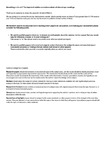Something in the air? The impact of volatiles on mollusc attack of oilseed rape seedlings
| dc.contributor.author | Shannon, RWR | |
| dc.contributor.author | Félix, A-E | |
| dc.contributor.author | Poppy, GM | |
| dc.contributor.author | Newland, PL | |
| dc.contributor.author | van Dam, NM | |
| dc.contributor.author | Hanley, ME | |
| dc.date.accessioned | 2016-06-30T14:03:00Z | |
| dc.date.available | 2016-06-30T14:03:00Z | |
| dc.date.issued | 2016-03-22 | |
| dc.identifier.issn | 0305-7364 | |
| dc.identifier.issn | 1095-8290 | |
| dc.identifier.uri | http://hdl.handle.net/10026.1/5001 | |
| dc.description.abstract |
BACKGROUND AND AIMS: Mounting concerns about balancing food security with the environmental impacts of agro-chemical use underpin the need to better understand the mechanisms by which crop plants, particularly during the vulnerable seedling stage, attract or repel herbivores. METHODS: The feeding preferences of the mollusc Helix aspersa were determined for several oilseed rape (Brassica napus) cultivars and a rank order of acceptability was established. This was compared with glucosinolate concentrations and volatile organic compound (VOC) profiles to determine whether seedling acceptability to molluscs was linked to either form of defence. KEY RESULTS: While VOC profiles for each oilseed rape cultivar could be separated by canonical discriminant analysis and associated with mollusc feeding preferences, glucosinolate profiles were unrelated to snail feeding behaviour. A mixture of monoterpenes (α-pinene, β-myrcene and δ-3-carene) was identified as a putative attractant, while a blend of the green leaf volatiles 3-hexen-1-ol, 3-hexen-1-ol acetate and the monoterpene α-terpinene was identified as a putative repellent mix. Added to the VOC profile of oilseed rape seedlings, the 'repellent' mix reduced mollusc selection, while the 'attractant' mix had no effect. CONCLUSIONS: Despite the widespread assumption that seedling selection by generalist herbivores is governed by chemical defence and taste, we show that olfactory cues may be more important. Oilseed rape may be atypical of wild plants, but our ability to identify repellent volatile organic compounds that can influence snail olfactory selection points to new methods for crop protection using modified VOC profiles during the vulnerable seedling stage. | |
| dc.format.extent | 1073-1082 | |
| dc.format.medium | Print-Electronic | |
| dc.language | en | |
| dc.language.iso | en | |
| dc.publisher | Oxford University Press (OUP) | |
| dc.subject | Brassica napus L. | |
| dc.subject | Brassicaceae | |
| dc.subject | crop protection | |
| dc.subject | food security | |
| dc.subject | green leaf volatiles | |
| dc.subject | Helix aspersa Muller | |
| dc.subject | monoterpenes | |
| dc.subject | plant volatiles | |
| dc.subject | seedling herbivory | |
| dc.subject | solid-phase microextraction | |
| dc.title | Something in the air? The impact of volatiles on mollusc attack of oilseed rape seedlings | |
| dc.type | journal-article | |
| dc.type | Article | |
| plymouth.author-url | https://www.ncbi.nlm.nih.gov/pubmed/27009912 | |
| plymouth.issue | 6 | |
| plymouth.volume | 117 | |
| plymouth.publication-status | Published | |
| plymouth.journal | Annals of Botany | |
| dc.identifier.doi | 10.1093/aob/mcw032 | |
| plymouth.organisational-group | /Plymouth | |
| plymouth.organisational-group | /Plymouth/Faculty of Science and Engineering | |
| plymouth.organisational-group | /Plymouth/Faculty of Science and Engineering/School of Biological and Marine Sciences | |
| plymouth.organisational-group | /Plymouth/REF 2021 Researchers by UoA | |
| plymouth.organisational-group | /Plymouth/REF 2021 Researchers by UoA/UoA06 Agriculture, Veterinary and Food Science | |
| plymouth.organisational-group | /Plymouth/Users by role | |
| plymouth.organisational-group | /Plymouth/Users by role/Academics | |
| dc.publisher.place | England | |
| dcterms.dateAccepted | 2016-01-08 | |
| dc.rights.embargodate | 2017-3-22 | |
| dc.identifier.eissn | 1095-8290 | |
| dc.rights.embargoperiod | Not known | |
| rioxxterms.versionofrecord | 10.1093/aob/mcw032 | |
| rioxxterms.licenseref.uri | http://www.rioxx.net/licenses/all-rights-reserved | |
| rioxxterms.licenseref.startdate | 2016-03-22 | |
| rioxxterms.type | Journal Article/Review |


